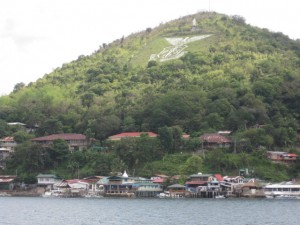
While island hopping in Coron, Palawan, our boat passed by Culion, the former leper colony, and I felt an involuntary shiver as I contemplated on how the people who contracted leprosy in the early 1900s were forcibly taken from their homes and brought here to live in isolation for the rest of their lives and died without any hope of a cure. How they must have blamed themselves for some imagined sin that warranted God’s wrath to be afflicted with a hideous disease. “He was unfaithful to the Lord his God…leprosy broke out on his forehead…the Lord had afflicted him. King Uzziah had leprosy until the day he died. He lived in a separate house – leprous, and banned from the temple of the Lord.”
Leprosy was once incurable and thought to be highly contagious that in 1907 the Philippine Commission passed Act 1711, which provides:
The Director of Health and his authorized agents are hereby empowered to cause to be apprehended, and detained, isolated, segregated, or confined, all leprous persons in the Philippine Islands, and upon application of the Director of Health it shall be the duty of every Insular, provincial, or municipal official having police powers to cause to be arrested and delivered to the Director of Health, or his agents, any person alleged or believed to be a leper…
Having leprosy in the first half of the 20th century was not unlike being a common criminal to be arrested and detained – and sentenced to life imprisonment not only in a lonely island but inside a numb body covered with lesions. Then in 1952 Act 1711 was amended by Republic Act No. 753:
Section 1058. The Director of Health or his authorized representative is empowered to cause all persons with leprosy or suspects in the Philippines to be subjected to the medical inspection and diagnostic procedure necessary to determine the presence or absence of leprosy. If it be found that the suspected person is positive bacteriologically for mycobacterium leprae, the Director of Health or his authorized representative shall turn him over to the Director of Hospitals or his authorized representative for isolation and segregation; and if it be found that the suspected person does not have leprosy, the Director of Health or his authorized representative shall assist in his conveyance to the place at which he was taken, at government expense, unless other satisfactory arrangements are made.
Section 1059. If the diagnosis is questioned, no person shall be removed to place of segregation until the diagnosis of leprosy had been verified positive bacteriologically.
The main difference here is that instead of being automatically apprehended, detained, isolated, etc., people suspected of having leprosy were now subjected to a medical diagnostic procedure to confirm if they are indeed carrying the contagious disease. However, there seemed to be no effective cure available at the time, so those positively diagnosed with leprosy were still isolated and segregated.
But with the advances in medical science, leprosy is no longer to be dreaded since it is not only treatable but curable (curable means the disease can be entirely eliminated while treatable means only the symptoms can be relieved), and the drugs are even free.
In fact, as early as 1964, Republic Act No. 753 was amended by Republic Act No. 4073, “An Act Further Liberalizing the Treatment of Leprosy by Amending and Repealing Certain Sections of the Revised Administrative Code.”
Sec. 1058. Persons afflicted with leprosy not to be segregated. — Except when certified by the Secretary of Health or his authorized representatives that the stage of the disease requires institutional treatment, no persons afflicted with leprosy shall be confined in a leprosarium: provided, that such person shall be treated in any government skin clinic, rural health unit or by a duly licensed physician.
Sec. 1059. Confinement and treatment in sanitarium when necessary. — Whenever a person afflicted with leprosy shall have developed the disease to such stage as to require institutional treatment and the leprosy officer shall so certify, the said person shall forthwith be sent to a government operated sanitarium and be treated therein until such time as the Secretary of Health or his authorized representative decides that institutional treatment is no longer necessary.
Thanks to modern medicine, we have come a long way since biblical times when lepers were pronounced unclean and separated from society, and when only a handful were healed by God/Jesus. By the year 2000, the World Health Organization and its partners in the medical community have actually eliminated leprosy as a public health problem, meaning the prevalence rate is now less than one case per 10,000 persons. Over the past 20 years, more than 14 million leprosy patients have been cured, and leprosy has been eliminated from 119 out of 122 countries. That’s quite an achievement for mere human beings with no divine powers to perform miracle cures, using science as their only tool, so lepers and non-lepers alike are indeed lucky to have lived in this century.
As for Culion, it is no longer a leper colony but a municipality, and its sanitarium has expanded into a general hospital that also provides health care services to neighboring municipalities including Coron, Busuanga, and El Nido. But being the erstwhile largest leprosarium in the world, Culion has invaluable contributions to the research and appreciation of leprosy as scientists from all over the world came here for the opportunity to study the disease in all its stages and manifestations.
As our boat sailed away from Culion, I took a moment of silence to honor the dead lepers of the island, the unsung heroes of medical progress that conquered one of the oldest maladies that plagued mankind. Thank you, guys. You did not suffer and die in vain.


Holy camote. Galing palang akong Coron. >_<
Haven't read the article yet, but I will later.